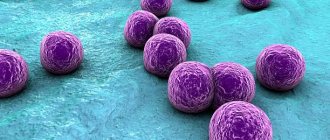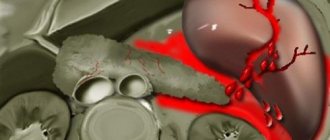Cancer diseases are characterized by pathological (uncontrolled) division of cellular structures. Atypical cells, due to continuous reproduction, invade adjacent tissues, eventually migrating to distant lymph nodes and organs. Here they promote the growth of new blood vessels that feed the neoplasm. The development of tumor cells is possible from any structure of the body.
Malignant tumors are one of the leading causes of mortality among the working-age population not only in our country, but throughout the world. Timely and high-quality diagnosis of the oncological process plays an important role in achieving stable remission or complete relief from the disease.
It can be difficult to recognize the first pathological signs on your own. This is due to the non-specificity of cancer symptoms. A specific symptom is one that is most characteristic of a certain group of diseases. The specificity of symptoms allows one to distinguish one nosology from another. For example: low-grade body temperature (from 37.2 to 37.9 degrees) is not a specific symptom. It occurs during ARVI, pregnancy, tuberculosis, poisoning and a number of other conditions.
Most often, the clinical picture of most oncopathologies at the initial stages is uninformative. An exception is melanoma, a skin cancer formed from pigment cells. A new growth in the form of a mole has the following characteristics: it grows quickly, changes shape and color. During a regular medical examination, such changes can be easily identified and timely oncological care can be started. In other forms of cancer, the first symptoms do not fully manifest themselves. The signs will be blurred and invisible until the enlarged tumor interferes with the functioning of certain organs. Unfortunately, this happens in the later stages of oncological pathology, when it becomes quite problematic to put the process into stable remission.
Primary symptoms of cancer
A malignant neoplasm develops in stages, remaining invisible to others and the patient for a long time. In this case, much depends on the location of the tumor: if it is located in a place where it is easy to palpate, there is a high probability of its early detection. Examples include oncological processes in the orbit, in the testicles. Even with a small size, a growing tumor can be detected by palpation. A different picture arises with kidney cancer: symptoms and signs do not appear immediately, since the oncological process has the ability to develop for a long time due to the free anatomical space. The patient complains of intense pain when the formation begins to compress the nerve endings. organs, nerve trunks and cause pain, which is why they are often detected in the later stages.
In this regard, it is dangerous to rely on only one symptomatology and subjective sensations. Doctors recommend regular examinations for preventive purposes. Specially designed oncological screenings (Check-Up) will help identify diagnostic signs of precancerous conditions or oncological pathology itself.
Still, there are a number of symptoms that cannot be ignored:
- Cough that does not go away within a month. Sputum with bloody streaks should cause concern. The situation is typical for bronchopulmonary infections, but the symptom can also become the initial manifestation of lung cancer.
- Changes in bowel movements. Hormonal imbalance, errors in diet, and stress cause similar changes: changes in the shape, character of stool, and frequency of bowel movements. The same symptoms accompany the early stages of development of intestinal neoplasia. Do not delay visiting a doctor if blood in the stool is added to the above.
- Anemia. Anemia can be a complication of various diseases. As one of the symptoms of colon cancer, anemia can be determined using laboratory tests.
- Changes in the mammary glands. You should contact a mammologist if you find a lump in the breast, a change in the shape of the breast or nipple, or its asymmetry. Cloudy or bloody discharge from the nipple and formations on the skin of the mammary glands (ulcerations, peeling) should also alert you.
- Urinary dysfunction. In men, complaints about difficulties with the free passage of urine, the admixture of blood in some cases are caused by oncopathology of the prostate gland and bladder. In women, such symptoms are sometimes the first manifestations of cancer of the reproductive system.
- Hoarseness. If hoarseness is not associated with surgical interventions in this area, chronic tonsillitis, or smoking, it is advisable to visit a doctor to rule out an oncological diagnosis.
- Lump in the scrotum. A painless, firm formation is the leading sign of testicular cancer.
- Enlarged lymph nodes. Against the background of infectious processes, enlargement and/or thickening of the lymph nodes is observed. After a month, the structure returns to its original size. If the lump persists, consult a doctor.
- Heartburn. Endoscopic examination is recommended for long-term heartburn or if there is no effect from taking special medications.
- Swallowing problems. An experienced doctor will conduct a differential diagnosis with esophageal cancer, since the symptom is one of its first signs. The complaint is also typical for thyroid cancer.
- Vaginal discharge. You should pay attention to purulent or bloody (heavy or spotting) discharge between menstrual cycles, after sexual intercourse, after the onset of menopause. During an oncological examination, the gynecologist will rule out or confirm the diagnosis of “uterine cancer” or “cervical cancer.”
- Unreasonable weight loss, chills, sweating at night. Complaints are often associated with thyroid dysfunction, parasitic, bacterial, and viral infections. In some cases, such a clinical picture is a manifestation of oncology.
- Bloating. Flatulence in combination with rapid saturation, changes in the frequency of urination, discomfort in the lumbar region and lower abdomen is a signal of a growing malignant neoplasm of the ovaries.
- Modification of a mole. At your appointment, your dermatologist will tell you what symptoms are observed with skin cancer. The leading changes in a mole are: a rapid increase in its size, blurred edges, and a change in color.
- Non-healing ulcers. With elevated blood sugar levels, ulcers and wounds on the skin and mucous membranes do not heal for a long time. The same symptoms (in both adults and children) are characteristic of cancer.
The symptoms described above are considered informative only if a person has complex complaints. If there is no history of other chronic diseases with corresponding manifestations, the current clinical picture should be especially alarming.
What are precancerous conditions?
Symptoms of cancer are direct evidence of the existence of a malignant tumor.
But such neoplasms sometimes develop not on healthy tissue, but on an already existing “substrate”. Certain disorders, which in medicine are usually called precancerous or background diseases, serve as such a “substrate”. Let us emphasize: such a pathology is not yet a cancerous tumor and it is far from a fact that it will necessarily arise in this place. However, identifying a precancerous lesion increases the likelihood of tumor development, which means the patient requires careful medical supervision. The most common precancerous conditions are:
- ulcers, cracks, erosions, as well as leukoplakia (“white spot”) on the mucous membranes of the oral cavity;
- papillomas, keratinization and benign (fibromas, adenomas, etc.) tumors in the larynx and nasopharynx;
- goiter of the thyroid gland, especially its nodular form;
- warts and nevi on the skin, areas of chronic weeping or trauma;
- diffuse and focal mastopathy of the mammary glands;
- chronic atrophic gastritis, gastric and duodenal ulcers;
- chronic ulcerative colitis, intestinal fistulas, polyps of the colon and rectum;
- chronic inflammatory lesions of the urinary system, as well as the prostate gland;
- benign tumors (adenoma) of the prostate;
- leuko- and erythroplakia of the vagina, erosions and ectropions of the cervix, any benign gynecological tumors (polyps, fibroids, fibroadenomas, etc.).
Late cancer symptoms
Oncological diseases in the later stages have a more definite clinical picture. At this stage, the tumor reaches a significant size and metastatic foci appear. Often it is metastases that provoke the severity of the clinical picture, aggravating the general condition of the patient.
Late symptoms of cancer include:
- A tumor node can be easily identified by a doctor or the patient himself by palpation (by palpation). The formation can be detected on the chest, skin, lymph nodes, and in the oral cavity.
- Pain syndrome. Discomfort occurs at the site of the enlarged tumor (usually at night). It is not controlled by non-steroidal anti-inflammatory drugs – aspirin, ibuprofen. There is a tendency towards a gradual increase in aching pain.
- Pathological discharge. They differ from the early signs of the oncological process in their particular abundance and frequency. With lung neoplasia, patients complain of a purulent-bloody admixture in the sputum, with cancer of the intestines and pelvic organs - the presence of blood in the discharge from the rectum, with a malignant process of the prostate and bladder - blood in the urine.
- Impaired functions of organs affected by the tumor. Shortness of breath and suffocation occur with lung disease, alternating constipation and diarrhea with pathology of the colon, restriction of movements and pathological fractures with cancer of the bone and joint system.
- Problems with skin and hair. A yellow tint to the skin is one of the symptoms of pancreatic cancer, a sign of neoplasms of the pituitary gland (part of the brain) - active growth of hair. Severe itching of the entire skin surface worries patients with liver cancer.
These and a number of other clinical manifestations have varying degrees of severity. This depends on the type of tumor, the stage of oncological pathology, the presence of concomitant chronic diseases, and the age of the patient.
TNM classification
TNM is the fundamental classification used throughout the world. It was developed back in the mid-20th century. Last revised in 2009. Subsequent revisions are planned as information about innovations in the diagnosis and treatment of cancer accumulates.
The classification abbreviation is informative; each letter carries information about the characteristics of a malignant formation:
- T (tumor) is a description of the initial tumor;
- N (nodus) – tumor migration to regional lymph nodes;
- M (metastasis) – presence of metastases.
When determining what stage the disease is at, the corresponding number or special designation is assigned to the letter.
Legend:
| Characteristics of the initial tumor | TX – the primary tumor has not been assessed. T0 – the primary tumor was not found. Tis - literally means: “cancer in situ”; a cluster of cancer cells has been detected that do not grow into neighboring tissues, that is, this is the initial stage of cancer. T1-4 – the number indicates the size of the tumor and the degree of its penetration into neighboring tissues. |
| Spread to regional lymph nodes | NX – it is impossible to evaluate regional lymph nodes. N0 – there are no cancer cells in the regional lymph nodes. N1-3 – the number indicates the degree of damage to regional lymph nodes by cancer cells. |
| Metastases | M0 – no metastases. M1 – metastases detected. |
Often, an additional letter is placed before the TNM designation, which is responsible for information about the method of diagnosis:
- p – established by a pathologist when studying the tumor under a microscope after removal;
- c – clinically diagnosed before biopsy.
Sometimes doctors prescribe an additional test called a sentinel biopsy. In essence, this is the study of the sentinel lymph node, that is, the closest lymph node in the direction of outflow of the malignant tumor. This study allows us to determine the condition of regional lymph nodes and the need for their removal and direction of treatment.
Common Cancer Symptoms
As a malignant tumor grows, toxins have an increasingly intense and powerful effect on the healthy structures of the body. As a result, a symptom complex develops, which has received the definition of “minor symptom syndrome.” Some types of neoplasia are characterized by the occurrence of this syndrome in the initial stages.
Main manifestations:
- rapid fatigue: even after quality sleep and rest, a person feels severe weakness, weakness, and is haunted by a constant desire to rest;
- performance decreases: the previous symptom entails a feeling of powerlessness and the inability to perform daily work to the usual extent;
- deterioration in sleep quality: disturbance of the REM and slow-wave sleep phases, “grossness” after waking up;
- poor appetite, aversion to certain foods;
- causeless and rapid weight loss;
- An increase in body temperature accompanies any symptom of cancer at every stage of the process.
Also, this symptom complex includes a decrease in immunity, manifested by frequent colds and exacerbation of chronic processes in the body. Frequent headaches, mood swings, and depression are all common symptoms and signs of cancer. While not specific to oncological pathology, in combination they should motivate a person to visit a doctor.
Sources
- American Cancer Society. How is cancer diagnosed?. Last reviewed: January 30, 2021.
- de Martel C., Georges D., Bray F., Clifford GM Global burden of cancer attributable to infections in 2021: a worldwide incidence analysis. Lancet Global Health. 2021, 8 (2), e180-e190.
- Ferlay J., Ervik M., Lam F., Colombet M., Mery L., Piñeros M., et al. Global Cancer Observatory: Cancer Today. Lyon: International Agency for Research on Cancer; 2021.
- National Cancer Institute of the United States of America. What is cancer? Last reviewed: March 28, 2021.
- National Health Service. United Kingdom. Cancer. Signs and symptoms. Last reviewed: 17 September 2021.
- World Health Organization. Health topics. Cancer. Overview, Prevention, Management. Last review: March 3, 2021.
- Hanahan D., Weinberg R.A. Key signs of cancer: the next generation. Cell, 2011, 114(5):646−674. Per. from English: Azat Murtazin. Medach. 2011.
When to see a doctor
A reasonable question arises: when should you contact a specialized specialist without wasting precious time? After all, many types of cancer pathology are asymptomatic for a long time, not showing themselves in the first stages.
A reliable way to determine the first symptoms of cancer is regular preventive examinations.
They are especially important for people at risk of developing cancer. Risk factors include:
- genetic predisposition;
- detection of certain genetic mutations during diagnosis;
- frequent contact with carcinogens and other toxic substances (occupational hazards);
- unfavorable environmental conditions;
- age factor.
The medical community has developed special diagnostic programs - screening studies that determine the presence or absence of a malignant neoplasm. Timely detection of cancer symptoms and undergoing a screening examination makes it possible to carry out the most effective treatment, achieve stable remission or complete recovery.
Doctors recommend the following screening tests:
- Mammary cancer. Women at any age are at risk of developing breast cancer. Every representative of the fairer sex should conduct a self-examination of the mammary glands once every couple of months. It is advisable to consult a mammologist at least once a year. After 40 years, you will need to perform mammography (a type of radiography), and, if indicated, an ultrasound examination of the breast.
- Stomach cancer. Stomach problems are determined by fibrogastroduodenoscopy (FGDS). Using the endoscopic method, one can easily diagnose certain changes in the mucous membrane of the esophagus, stomach, and duodenum.
- Colon cancer. People of both sexes after 50 years of age should undergo fibrocolonoscopy. Examination of the mucous membrane with an endoscope reveals precancerous conditions (ulcerative colitis or Crohn's disease) or a cancerous tumor itself.
- Lungs' cancer. Medical experts recommend low-dose CT scans once a year for the following groups of people: ages 55 to 75 years; smokers aged 40 years and older; former smokers (quit within the last 15 years).
- Skin cancer. Alarming changes in moles, warts or birthmarks can be diagnosed by a dermatologist using dermatoscopy. It is advisable to undergo the procedure annually.
General diagnostics of oncopathology is also carried out. The examination involves performing a number of diagnostic measures:
- Lab tests:
- Determination of the level of tumor markers in the blood.
- Molecular genetic analysis. It allows you to identify specific mutations that predetermine the risk of developing an oncological process.
- DNA diagnostics of closest blood relatives. The procedure makes it possible to find out the risk of the disease in all family members.
- Ultrasound. The undoubted advantages of the method: it is carried out quickly, safely, and is affordable.
- MRI, . An examination will be required if previous diagnostic results raise suspicions among the attending physician about the presence of an oncological process.
- Endoscopic diagnostics. With its help, you can see the tumor with your own eyes through the optics of the endoscope.
- Carrying out a biopsy. The purpose of the event is to analyze a tissue sample of the affected organ. This is followed by a conclusion about the presence or absence of atypical structures.
Cost of diagnostic procedures
| Oncological Check-Up basic | 44,000 rub. |
| Comprehensive Colono-Gastro program | 49300 rub. |
| Comprehensive diagnostic program EndoUS | 71,000 rub. |
| Appointment with a mammologist | 5100 rub. |
| Appointment with an oncologist | 5100 rub. |
| Digital videodermatoscopy Photofinder | 13400 rub. |
Book a consultation 24 hours a day
+7+7+78
Abdominal pain
One of the most common diseases of the pancreas is pancreatitis. It manifests itself as sudden and severe pain throughout the abdomen, mainly in the epigastric region.
Severe abdominal pain due to pancreatitis
Pancreatitis can be caused by poor diet or gallstones. The disease poses a very serious threat to human life.
Important symptoms are that blood pressure drops rapidly, heart rate increases, and sometimes even cardiovascular collapse occurs.
Recurrent infections
Frequent respiratory infections and colds that last more than 2 weeks should not be underestimated. If the patient also has enlarged lymph nodes or is weakened, a blood test should be taken. This condition may accompany neoplastic diseases of the lymphatic system: Hodgkin's disease or non-Hodgkin's lymphoma.
Frequent respiratory infections
Hodgkin's disease affects 800 to 1,000 people each year. Men get sick more often. The peak incidence is observed in two age groups: from 18 to 30 and from 50 to 55 years. The main tests for identifying lymphoma are: a complete blood count and ESR (the norm is from 10 to 20 depending on gender; in tumor diseases, the ESR ranges from 70-80 or even 100), determination of the enzyme LDH (typical for lymphomas).
Also important are the results of tests for liver enzymes, urea, creatinine, sugar levels, front and side chest x-rays, as well as abdominal ultrasound.
Tumor assessment after surgery
Postoperative classification allows oncologists to assess the success rate of treatment performed through surgery:
- RX reports that it is not possible to assess the presence of tumor cells in the body after surgery;
- R0 states that there is no tumor in the body after surgery;
- R1 says that microscopic examination revealed residual tumor foci;
- R2 disappointingly reports that even without a microscope, a tumor is detected in the patient’s body.
Methods for diagnosing cancer diseases
There are many different diagnostic methods, each of which can determine the diagnosis with varying degrees of accuracy. In this case, when making a diagnosis, a classification is used that allows one to understand the diagnostic methods and the degree of accuracy:
- C1 – standard diagnostic methods (examination, radiography, endoscopy) are less accurate;
- C2 – more accurate diagnostic methods were used (biopsy, CT, MRI, endosonography and others);
- C3 – cytological and histological studies of damaged tissue obtained through surgery.
- C4 – the diagnosis was established only after a full surgical operation to remove the tumor.
Degree of tumor malignancy
The success of the chosen therapy, the likelihood of relapses and the chances of remission depend on how aggressively the affected cells behave. Because of this, experts have developed a system for assessing the degree of malignancy, in other words, aggressiveness:
- GX is assigned when the degree of aggressive impact cannot be assessed;
- G1 means that the tumor tissue is similar to normal tissue, but still behaves aggressively (albeit to a lesser extent). At this stage, metastases do not appear;
- G2 indicates that significant differences between cancer and normal cells are visible under the microscope;
- G3 and G4 indicate that there is no possibility of treatment, since the cells behave extremely aggressively and practically do not respond to therapy.
Who makes the diagnosis
Conducting an extensive examination and formulating a final diagnosis is the responsibility of oncologists. Doctors have special training, which allows them to quickly and accurately diagnose most types of malignant tumors. However, therapists and specialized specialists play an equally important role: there are a number of suspicious symptoms that need to be looked for when examining patients with various complaints. This approach is called cancer vigilance.
Heartburn
Heartburn is often caused by neurotic disorders, but in the vast majority of cases, the disease is a consequence of the reverse flow of acidic stomach contents into the esophagus and even into the oral cavity. This phenomenon, known as gastroesophageal reflux, is caused by disruption of the natural barrier between the esophagus and stomach (primarily the lower esophageal sphincter).
Heartburn can also be a sign of functional dyspepsia, malignant neoplasm, biliary tract diseases or gastritis. The latter develops as a result of an imbalance between protective factors and aggressive factors, including Helicobacter pylori infection. Long-term infection with this bacterium can contribute to the development of stomach cancer. Therefore, you should not treat this symptom yourself.
Heartburn
Cough
The main cause of chronic cough is cigarette smoking. This cough is the result of irritation caused by chemicals in cigarette smoke. But the same toxic compounds that cause a smoker's cough can also cause much more serious problems, such as bronchitis, emphysema, pneumonia and lung cancer.
Chronic cough should always be considered a warning sign by smokers. The accompanying symptoms should be especially concerning: fever, hemoptysis, shortness of breath, weight loss, weakness, fatigue, loss of appetite, chest pain not caused by coughing, night sweats, wheezing in the lungs.
Cough
A few words about other types of malignant tumors
A number of diseases are so non-standard that it is not possible to apply the TNM system to them. Let's talk about them. Tumors in children are very different from malignant tumors in the body of an adult and deserve consideration in a separate article. Blood cancer has different names (leukemia, lymphoma, myeloma, etc.), but invariably does not have a specific density and specific localization, due to which it cannot be classified according to the TNM system. Tumors of the nervous system are localized in the brain and spinal cord. They do not have their own generally accepted classification, so the letter T is used to determine the stage.










